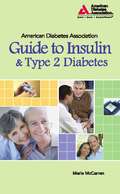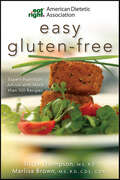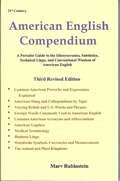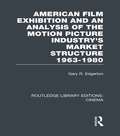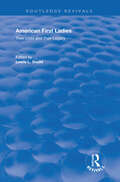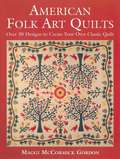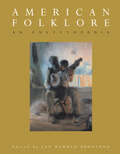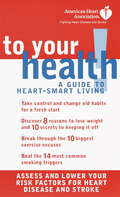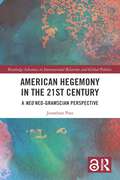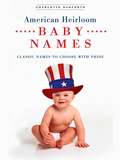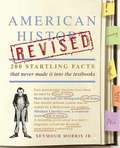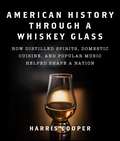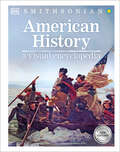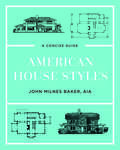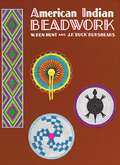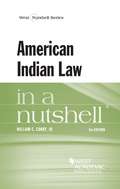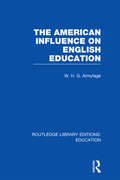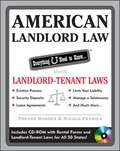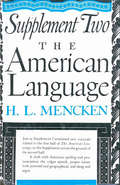- Table View
- List View
American Diabetes Association Guide to Insulin and Type 2 Diabetes
by Marie MccarrenUser-friendly guide covers all aspects of insulin use in type 2 diabetesThe American Diabetes Association Guide to Insulin & Type 2 Diabetes addresses common fears about insulin therapy and what is involved with beginning to use insulin. Additional chapters discuss fine-tuning of insulin self-management, gadgets to make life easier, and troubleshooting steps to overcome any problems readers may have.
American Dietetic Association Easy Gluten-Free: Expert Nutrition Advice with More than 100 Recipes (American Dietetic Association Ser.)
by Shauna James Ahern Tricia Thompson Marlisa BrownFrom the ADA-the complete guide to a healthy gluten-free dietHave you or a family member been diagnosed with celiac disease or non-celiac gluten sensitivity? Are you worried that "gluten-free" means boring, bland, and lacking in nutrition? Worry no more. This book will show you how to bring the benefits of delicious, gluten-free whole grains back into your diet and whip up delicious dishes you'll be proud to share with family and friends. From the foremost authority on nutrition, ADA Easy Gluten-Free arms you with cutting-edge information and easy-to-follow recipes to develop healthy gluten-free meals packed with flavor and variety. Learn about the plethora of gluten-free whole grains: how to select them, cook them, and use them in all your meals and snacks Browse more than 130 nutritious and delicious gluten-free recipes for any of your dining needs, from starters and main courses to sides, breads, and desserts Try simple and tempting dishes such as Sweet Potato Quesadillas , Quinoa with Roasted Garlic and Shrimp, Oatmeal Pear Spice Muffins , and Chocolate Sponge Cake with Chocolate Glaze Learn the basics of healthy gluten-free nutrition, choosing gluten-free ingredients, reading labels, and much more Start with four easy weeks of gluten-free meal plans to help you jumpstart and maintain a healthy gluten-free lifestyle Find easy-to-follow information on how to on how to choose and use tasty gluten-free whole grains, from brown rice and oats to millet, teff, and sorghumSo many quick and easy dishes and creative recipes make the book a must for any culinary library.
American English Compendium
by Marv RubinsteinA compendium of American proverbs, expressions, slang, colloquialisms; British-US glossary; abbreviations and acronyms; and other various odds and ends. Widely used by non-native speakers and translators.
American Film Exhibition and an Analysis of the Motion Picture Industry's Market Structure 1963-1980 (Routledge Library Editions: Cinema)
by Gary EdgertonThis study looks at how the movie industry organisation functioned between the late ‘40s and 1983 when it was originally published. It describes the changing role of domestic exhibition through this time and analyses the wider film industry to provide a model of the exhibition structure in relation to production, distribution and outside factors. It addresses the growing issues of the cable and video markets as competition to the film exhibition business at that time and looks forward into a highly turbulent environment. With particular interest now as the film industry address a new range of threats and adaptations of its working structure, this book offers and integral understanding of a key stage in cinema history.
American First Ladies: Their Lives and Their Legacy
by Lewis L. GouldAn historical survey of the impact of individual First Ladies' impact on America and the American woman. A selection of each woman's own writings is given along with a commentary on her influence, and a biography of her life, and the narrative covers all the presidents' wives from Martha Washington to Hillary Rodham Clinton.
American First Ladies: Their Lives and Their Legacy
by Lewis L. GouldThis volume presents thirty-nine interpretive biographical essays on all first ladies, from Martha Washington to America's newest First Lady, Laura Bush. This new edition contains updated material on all the living First Ladies and updated bibliographies for each entry, as well as a portrait of the newest First Lady.
American Folk Art Quilts: Over 30 Designs to Create Your Own Classic Quilt
by Maggi McCormick GordonA Step-by-Step Guide to Creating Beautiful Quilts! Beautiful antique quilts and a workbook of patterns come together in this lavish photography book for quilters. The more than 30 featured quilts from the Wisconsin State Historical Society collection are displayed in period rooms at Old World Wisconsin, the Society's outdoor museum of German and Scandinavian farmhouses. Patterns and block layouts are provided for replicating each of the original quilts, and after seeing each of them in a true historical context, home sewers will be inspired to create their own versions.
American Folklore: An Encyclopedia
by Jan Harold BrunvandContains over 500 articles Ranging over foodways and folksongs, quiltmaking and computer lore, Pecos Bill, Butch Cassidy, and Elvis sightings, more than 500 articles spotlight folk literature, music, and crafts; sports and holidays; tall tales and legendary figures; genres and forms; scholarly approaches and theories; regions and ethnic groups; performers and collectors; writers and scholars; religious beliefs and practices. The alphabetically arranged entries vary from concise definitions to detailed surveys, each accompanied by a brief, up-to-date bibliography.Special features *More than 2000 contributors *Over 500 articles spotlight folk literature, music, crafts, and more *Alphabetically arranged *Entries accompanied by up-to-date bibliographies *Edited by America's best-known folklore authority
American Government 101: From the Continental Congress to the Iowa Caucus, Everything You Need to Know About US Politics (Adams 101 Series)
by Kathleen SearsAll you need to know about elections, politics, and government! Too often, textbooks turn the noteworthy details of government into tedious discourse that would put even the president to sleep. American Government 101 cuts out the boring explanations, and instead provides a hands-on lesson that keeps you engaged as you learn. From the backstory of the Constitution to the institution of the Electoral College, this primer is packed with hundreds of entertaining tidbits and concepts to help you learn about how the government of the United States actually works. So whether you want to learn about how policies and laws are created, or just want to become a better-informed voter, American Government 101 has all the answers--even the ones you didn't know you were looking for.
American Hazardscapes: The Regionalization of Hazards and Disasters
by Natural Hazardas DisasterBarrier islands. Flood plains. Earthquake faults. Sometimes the environment poses threats to our well being, yet many of us continue to choose to live in risky or dangerous places. And on top of the “knowns” are the other, more hidden hazards related to environmental contamination that pose equally serious threats to our health and well being.But where are these places and what types of hazards are found there? American Hazardscapes examines the risks associated with living and owning property in diverse regions across the United States, offering dual perspectives: that of the geographer and that of the social science hazards researcher. The book summarizes what we already know about regional patterns of hazard events and losses during the previous three decades and goes further to shed light on the nature of the events themselves and their impact on society.Written for the relocating citizen and the policy maker alike, American Hazardscapes presents a regional ecology of disaster-prone or disaster-resistant states. It also offers thoughts on what local, state, and federal managers need to do to meet the challenge of reducing hazard losses in the next century.
American Heart Association To Your Health!: A Guide to Heart-Smart Living (American Heart Association)
by American Heart AssociationWhether you're a couch potato, diet dropout, or heavy smoker, it's hard to change old habits. But with this step-by-step guide, you can do it!You'll learn how to set realistic goals and follow through on them, plus stick to your new healthful habits. Stories of how other real people overcame the same hurdles will motivate you.* Find physical activities that are fun for you. Reward yourself in healthful ways for your fitness achievements.* Create a personalized eating plan that you can really live with*Learn how to identify your most common smoking triggers. Discover ways to beat those urges and kick the habit for good.* Find out how to get reliable information and become proactive about your health.This friendly little book is filled with tips and can help you change for the better. You'll take charge of your health and celebrate again and again. To your Health!
American Hegemony in the 21st Century: A Neo Neo-Gramscian Perspective (Routledge Advances in International Relations and Global Politics)
by Jonathan PassFor many years now debates over America hegemony and its supposed decline have circulated academic circles. The neo-Gramscians have greatly enriched our knowledge in this field, developing some key theoretical tools and concepts, yet ontological inconsistencies, notably the downgrading of structure, has meant their explanation of the dynamics of the contemporary world order remains somewhat incomplete. In this book, Jonathan Pass aims to counter such oversights, drawing directly on the ideas of Antonio Gramsci (amongst others) to elaborate a more sophisticated, overtly materialist, theory of world hegemony, rooted in a critical realist philosophy of science. Through the lens of this Neo neo-Gramscian (NNG) approach the book examines the complex interplay of internal and external social forces responsible for the evolving 'nature' of US hegemony, from its establishment in the 1940s, passing through its different stages of crisis and restructuring up to the present. China's spectacular rise undoubtedly constitutes a 'world event', but is it potentially a 'world hegemon'? The book seeks to sheds some light on this question, analysing the economic and geopolitical significance of China's emergence and how it affects, and is affected by, both American hegemony and its own extremely delicate 'passive revolution' at home. American Hegemony in the 21st Century presents a major contribution to International Relations, International, Political Economy, Politics and Philosophy and will be of interest to researchers looking for a more sophisticated and convincing analysis of the dynamics of the contemporary world order.
American Heirloom: Baby Names
by Charlotte DanforthOver 1,500 timeless American names for today's baby. Appealing and timeless, the names in this book are gathered from the pages of our history books and rooted in the nation's heartland. They are the names of real-life American poets and soldiers, artists and pioneers, entrepreneurs, teachers, and athletes. Distinctive and prestigious names can give children instant, natural role models-the heroes and positive idols who have had their names before. Entries in this unique guide include: - Classic names and descriptions of the heroic Americans who bore them - References to writings by and about each namesake that families can enjoy together - Historic sites related to each heirloom name suitable for family field trips - Famous names in all ethnic groups - The greatest names in medicine, law, statecraft, sports, business, philanthropy, exploration, invention, and more - Print features and reviews
American History Revised: 200 Startling Facts That Never Made It into the Textbooks
by Seymour Morris Jr.This spirited reexamination of American history (1776-2000) digs deep into our past to expose 200 startling facts that never made it into the textbooks, and highlights how little-known individuals and events played surprisingly influential roles in the great American story. We tend to think of history as settled, set in stone, but American History Revised is filled with evidence that American history is filled with ironies, surprises, and misconceptions. As author Seymour Morris, Jr. colorfully illustrates through the 200 historical vignettes that make up this book, much of our nation's past is quite different - and far more remarkable -- than we thought. Here we learn that in 1932, the U.S. Navy staged a mock attack on Pearl Harbor that resulted in the conclusion that the entire fleet of ships and planes stationed there were vulnerable to being wiped out on a Sunday morning. The Navy swore such an event could never happen and then forgot about it. The Japanese, however, noticed. And on December 7th, 1941, they copied the military exercise exactly. We also discover that: * America's largest corporation has never appeared on a Fortune 500 list * The two generals who ended the Civil War weren't Grant and Lee * The #1 best-selling American book of all time was written in one day * The Dutch made a bad investment buying Manhattan for $24 * Two young girls aimed someday to become First Lady - and succeeded * Three private financiers saved the U.S. from bankruptcy. Organized into ten thematic chapters, American History Revised plumbs American history's numerous inconsistencies, twists and turns to make it come alive again. Written in a lucid, often puckish style and backed by serious scholarship, extensive footnotes, and 50 illustrations, this book will leave readers astonished and entertained.
American History Through a Whiskey Glass: How Distilled Spirits, Domestic Cuisine, and Popular Music Helped Shape a Nation
by Harris CooperExperience American history like never before with this unique, informative, and fun guide for history buffs, whiskey enthusiasts, folks who like to cook at home, and fans of popular music.American History Through a Whiskey Glass presents a unique perspective on American history. It describes how bourbon and rye whiskey played a role in the most important events in American history, including the voyage of the Mayflower, George Washington&’s failed and successful political campaigns, the Civil War, pioneers moving west, Prohibition (of course), plus many more into the twenty-first century. It does so with descriptions of historical events but also with amusing anecdotes and humorous quotes from the historical figures themselves. The book carefully aligns five elements: a narrative about whiskey&’s role in eight periods of American historydescriptions and tasting notes for American whiskeys that represent distilled spirits in each historical periodtutorials on how whiskey is produced and its numerous varietiesperiod-specific food recipes drawn mostly from historical cookbooksplaylists of the popular music during each period The book gives readers an integrated and entertaining perspective on popular culture in America at different times, revealing how Americans have politicked, drank their native spirits, ate, and sang. But it does more; readers will not only learn about America&’s history, they can experience it through numerous illustrations, whiskey tasting, food, and music. It provides an opportunity for readers to be involved in a truly immersive approach to life-long learning . . . and it&’s fun.
American History: A Visual Encyclopedia (DK Children's Visual Encyclopedias)
by DKUncover the key moments that shaped American history in this extensive history encyclopedia for children. This complete encyclopedia of American history showcases the incredible journey the United States of America has made to become the major 21st-century power it is today.American History: A Visual Encyclopedia is the ultimate reference tool for children aged 9+ to explore the history of one of the most remarkable nations in the world. Get the background on the Battle of Yorktown and discover what started the American Revolution. Learn the legends of the Wild West, and relive the atmosphere of the &“Roaring Twenties&”! This history encyclopedia covers everything from the cultures of the indigenous peoples of North America right up to the events of the present day. This ultimate US history encyclopedia for kids offers: A comprehensive reference guide that covers US history from the first peoples to the present day.Fully updated information and a fresh design in this new edition, featuring the Biden presidency, the coronavirus pandemic, climate change and environmental issues, and other recent historical events.More than 750 images providing a visual account of American History.Created in collaboration with the Smithsonian Institution, American History: A Visual Encyclopedia gives detailed historical information and brings it to life with more than 750 photographs and paintings, plus extensive maps, charts, and state-specific information. Each double-page feature focuses on one aspect of the Union&’s history, be it the Civil War or civil rights, the Great Depression or the Moon landing. Complete texts of the Declaration of Independence and the U.S. Constitution are included in this visual encyclopedia for easy reference classroom work or reports.
American Homelessness: A Reference Handbook (3rd edition)
by Mary Ellen HombsHombs (of the Massachusetts Housing and Shelter Alliance) offers a collection of reference materials that provide information on the pervasive problem of homelessness in the United States. Nine chapters offer a chronology of the homeless problem, brief biographical sketches of 20 people who have had an effect on homeless policy and research, statistical information, documents and government reports, legislation from the U.S. and Europe written to address the problem, a list of print and nonprint resources, and a directory of organizations and government agencies. Also included is a brief analysis and discussion of the problem, comparing Europe and the United States.
American House Styles (Second edition): A Concise Guide
by John Milnes Baker“An engaging historical account and an attractive, practical resource.” —Booklist Colonial, Neoclassical, Queen Anne, Craftsman—what distinguishes one architectural style from another? This unique book will allow readers to recognize the architectural features and style of virtually any house they encounter. Here, architect John Milnes Baker explains the historical, cultural, and technical influences that shaped each of these styles and many more. Organized in periods, from Early Colonial (1600–1715) to the Modern Movement (1920–60) and beyond, this tour of America’s varied residential architecture is rendered in elevation drawings that precisely illustrate the key characteristics of each style. Nearly 25 years since the original publication of American House Styles, this updated edition includes a new preface and house styles from the mid-1990s to the present—from the rise and fall of the McMansion to energy-efficient, regionally influenced homes. The illustrations, now in color, are more delightful than ever in a new, larger format. This a must-have volume for anyone interested in architecture or adding a bit of style to their home.
American Indian Beadwork
by W. Ben Hunt J.F. "Buck" BurshearsOne of the original classical books on Indian beadwork art. Includes detailed directions for various beading stitches as well as making and stringing a loom.
American Indian Law in a Nutshell, 6th Edition
by William C. CanbyThis guide provides a reliable resource on American Indian law. The text covers the essentials of this complex body of law, with attention to the governmental policies underlying it. The work emphasizes both the historical development of Federal Indian Law and recent matters such as the evolution of Indian gaming, issues arising under the Indian Child Welfare Act, and the present enforcement of treaty rights.
American Influence on English Education (Routledge Library Editions: Education)
by W H ArmytageThe American ideal has exercised a powerful influence over English educational policy over the last two centuries, even as it has itself changed. Today the very size of America enables it to rehearse problems we shall meet tomorrow. This volume answers key questions for education, as relevant now as they were when it was originally published: Is there an optimal size and a maximal use of a school? Are there adequately sophisticated batteries of attainment tests? Or valid methods of vocational guidance?
American Jewish Landmarks: A Travel Guide and History, Volume I
by Bernard Postal Lionel Koppman"American Jewish Landmarks" contains valuable historical data on all 50 states, Washington, D.C., Puerto Rico, and the Virgin Islands; and is required reading for people interested in the Jewish landmarks of the United States and her territorial possessions. It is also worth bearing in mind that this book is more than a manual for the tourist, it is an important book for students of American Jewish history.
American Landlord Law
by Trevor Rhodes Nicole FevrierAmerican Landlord Law - the most reliable source of landlord-tenant information available provided by the nation's leading tenant screening company, AmerUSA.net. Every states' most common landlord-tenant laws (including D.C.'s) have been referenced in a manner that can be easily read and understand, a user-friendly style inherent to every book in this Everything U Need to Know... series.
American Language Supplement 1
by H.L. MenckenPerhaps the first truly important book about the divergence of American English from its British roots, this survey of the language as it was spoken-and as it was changing-at the beginning of the 20th century comes via one of its most inveterate watchers, journalist, critic, and editor HENRY LOUIS MENCKEN (1880-1956).In this replica of the 1921 "revised and enlarged" second edition, Mencken turns his keen ear on:• the general character of American English• loan-words and non-English influences• expletives and forbidden words• American slang• the future of the language• and much, much more.Anyone fascinated by words will find this a thoroughly enthralling look at the most changeable language on the face of the planet.
American Language Supplement 2
by H. L. MenckenThe DEFINITIVE EDITION OF The American Language was published in 1936. Since then it has been recognized as a classic. It is that rarest of literary accomplishments--a book that is authoritative and scientific and is at the same time very diverting reading. But after 1936 HLM continued to gather new materials diligently. In 1945 those which related to the first six chapters of The American Language were published as Supplement I; the present volume contains those new materials which relate to the other chapters.The ground thus covered in Supplement II is as follows:1. American Pronunciation. Its history. Its divergence from English usage. The regional and racial dialects.2. American Spelling. The influence of Noah Webster upon it. Its characters today. The simplified spelling movement. The treatment of loan words. Punctuation, capitalization, and abbreviation.3. The Common Speech. Outlines of its grammar. Its verbs, pronouns, nouns, adjectives, and adverbs. The double negative. Other peculiarities.4. Proper Names in America. Surnames. Given-names. Place-names. Other names.5. American Slang. Its origin and history. The argot of various racial and occupational groups.Although the text of Supplement II is related to that of The American Language, it is an independent work that may be read profitably by persons who do not know either The American Language or Supplement I.
